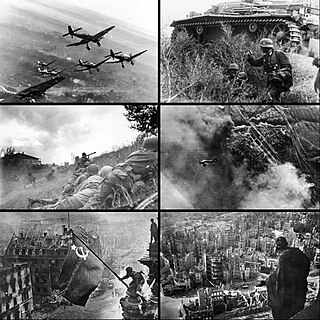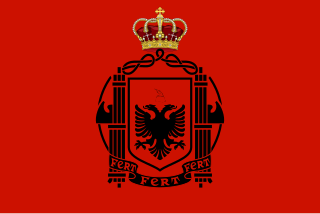
The Axis powers, originally called the Rome–Berlin Axis and also Rome–Berlin–Tokyo Axis, was a military coalition that initiated World War II and fought against the Allies. Its principal members were Nazi Germany, the Kingdom of Italy and the Empire of Japan. The Axis were united in their far-right positions and general opposition to the Allies, but otherwise lacked comparable coordination and ideological cohesion.

In Albania, World War II began with its invasion by Italy in April 1939. Fascist Italy set up Albania as its protectorate or puppet state. The resistance was largely carried out by Communist groups against the Italian and then German occupation in Albania. At first independent, the Communist groups united in the beginning of 1942, which ultimately led to the successful liberation of the country in 1944.

The European theatre of World War II was one of the two main theatres of combat during World War II. It saw heavy fighting across Europe for almost six years, starting with Germany's invasion of Poland on 1 September 1939 and ending with the Western Allies conquering most of Western Europe, the Soviet Union conquering most of Eastern Europe including the German capital Berlin, and Germany's unconditional surrender on 8 May 1945 although fighting continued elsewhere in Europe until 25 May. On 5 June 1945, the Berlin Declaration proclaiming the unconditional surrender of Germany to the four victorious powers was signed. The Allied powers fought the Axis powers on two major fronts, but there were other fronts varying in scale from the Italian campaign, to the Polish Campaign, as well as in a strategic bombing offensive and in the adjoining Mediterranean and Middle East theatre.

The German invasion of Greece, also known as the Battle of Greece or Operation Marita, was the attacks on Greece by Italy and Germany during World War II. The Italian invasion in October 1940, which is usually known as the Greco-Italian War, was followed by the German invasion in April 1941. German landings on the island of Crete came after Allied forces had been defeated in mainland Greece. These battles were part of the greater Balkans Campaign of the Axis powers and their associates.

The Mediterranean and Middle East Theatre was a major theatre of operations during the Second World War. The vast size of the Mediterranean and Middle East theatre saw interconnected naval, land, and air campaigns fought for control of the Mediterranean, North Africa, the Horn of Africa, the Middle East and Southern Europe. The fighting lasted from 10 June 1940, when Italy entered the war on the side of Germany, until 2 May 1945 when all Axis forces in Italy surrendered. However, fighting would continue in Greece – where British troops had been dispatched to aid the Greek government – during the early stages of the Greek Civil War.

The Greco–Italian War, also called the Italo–Greek War, Italian Campaign in Greece, and the War of '40 in Greece, took place between the kingdoms of Italy and Greece from 28 October 1940 to 23 April 1941. This local war began the Balkans campaign of World War II between the Axis powers and the Allies and eventually turned into the Battle of Greece with British and German involvement. On 10 June 1940, Italy declared war on France and the United Kingdom. By September 1940, the Italians had invaded France, British Somaliland and Egypt. This was followed by a hostile press campaign in Italy against Greece, accused of being a British ally. A number of provocations culminated in the sinking of the Greek light cruiser Elli by the Italians on 15 August. On 28 October, Mussolini issued an ultimatum to Greece demanding the cession of Greek territory, which the Prime Minister of Greece, Ioannis Metaxas, rejected.

The military history of Greece during World War II began on 28 October 1940, when the Italian Army invaded Greece from Albania, beginning the Greco-Italian War. The Greek Army temporarily halted the invasion and pushed the Italians back into Albania. The Greek successes forced Nazi Germany to intervene. The Germans invaded Greece and Yugoslavia on 6 April 1941, and overran both countries within a month, despite British aid to Greece in the form of an expeditionary corps. The conquest of Greece was completed in May with the capture of Crete from the air, although the Fallschirmjäger suffered such extensive casualties in this operation that the Oberkommando der Wehrmacht abandoned large-scale airborne operations for the remainder of the war. The German diversion of resources in the Balkans is also considered by some historians to have delayed the launch of the invasion of the Soviet Union by a critical month, which proved disastrous when the German Army failed to take Moscow.
Operation Lustre was an action during the Second World War: the movement of British and other Allied troops from Egypt to Greece in March and April 1941, in response to the failed Italian invasion and the looming threat of German intervention.

The history of Bulgaria during World War II encompasses an initial period of neutrality until 1 March 1941, a period of alliance with the Axis Powers until 8 September 1944, and a period of alignment with the Allies in the final year of the war. Bulgarian military forces occupied with German consent parts of the Kingdoms of Greece and Yugoslavia which Bulgarian irredentism claimed on the basis of the 1878 Treaty of San Stefano. Bulgaria resisted Axis pressure to join the war against the Soviet Union, which began on 22 June 1941, but did declare war on Britain and the United States on 13 December 1941. The Red Army entered Bulgaria on 8 September 1944; Bulgaria declared war on Germany the next day.

In the 19th century, the national revival in the Balkans began; national and religious antagonism flared, and conflict was heightened by the Ottoman policy of playing one group against the other. Meanwhile, the Ottoman Empire lost control over the major sections of Greece, Serbia, and Bulgaria, each of which claimed Macedonia on historical or ethnical grounds.

The invasion of Yugoslavia, also known as the April War or Operation 25, was a German-led attack on the Kingdom of Yugoslavia by the Axis powers which began on 6 April 1941 during World War II. The order for the invasion was put forward in "Führer Directive No. 25", which Adolf Hitler issued on 27 March 1941, following a Yugoslav coup d'état that overthrew the pro-Axis government.

The occupation of Greece by the Axis Powers began in April 1941 after Nazi Germany invaded the Kingdom of Greece to assist its ally, Italy, in their ongoing war that had started in October 1940. Following the conquest of Crete, the entirety of Greece was occupied starting in June 1941. The occupation of the mainland lasted until Germany and its ally Bulgaria withdrew under Allied pressure in early October 1944, with Crete and some other Aegean islands being surrendered to the Allies by German garrisons in May and June 1945, after the end of World War II in Europe.

The Italian protectorate of Albania, also known as Italian Albania, the Kingdom of Albania or Greater Albania, existed as a puppet state and protectorate of Fascist Italy. It was practically a union between Italy and Albania, officially led by Italian King Victor Emmanuel III and its government: Albania was led by Italian governors, after being militarily occupied by Italy, from 1939 until 1943. During this time, Albania ceased to exist as an independent country and became an autonomous part of the Italian Empire. Officials intended to make Albania part of a Greater Italy by assimilating Albanians as Italians and colonizing Albania with Italian settlers from the Italian Peninsula to transform it gradually into an Italian land.

The Italian invasion of Albania was a brief military campaign which was launched by the Kingdom of Italy against the Albanian Kingdom in 1939. The conflict was a result of the imperialistic policies of the Italian prime minister and dictator Benito Mussolini. Albania was rapidly overrun, its ruler King Zog I went into exile in neighboring Greece, and the country was made a part of the Italian Empire as a protectorate in personal union with the Italian Crown.

The Adriatic campaign of World War II was a minor naval campaign fought during World War II between the Greek, Yugoslavian and Italian navies, the Kriegsmarine, and the Mediterranean squadrons of the United Kingdom, France, and the Yugoslav Partisan naval forces. Considered a somewhat insignificant part of the naval warfare in World War II, it nonetheless saw interesting developments, given the specificity of the Dalmatian coastline.

The German–Turkish Treaty of Friendship was a non-aggression pact signed between Nazi Germany and Turkey on 18 June 1941 in Ankara by German ambassador to Turkey Franz von Papen and Turkish Minister of Foreign Affairs Şükrü Saracoğlu. It went into effect on the same day.

The Government of the Kingdom of Yugoslavia in Exile was an official government-in-exile of Yugoslavia, headed by King Peter II. It evacuated from Belgrade in April 1941, after the Axis invasion of the country, and went first to Greece, then to Palestine, then to Egypt, and finally, in June 1941, to the United Kingdom. Hence, it is also referred to as the "Government in London".
On 25 March 1941, Yugoslavia signed the Tripartite Pact with the Axis powers. The agreement was reached after months of negotiations between Germany and Yugoslavia and was signed at the Belvedere in Vienna by Joachim von Ribbentrop, German foreign minister, and Dragiša Cvetković, Yugoslav Prime Minister. Pursuant to the alliance, the parties agreed that the Axis powers would respect Yugoslav sovereignty and territorial integrity, including the Axis refraining from seeking permission to transport troops through Yugoslavia or requesting any military assistance.

During the German invasion of Greece on 6 April 1941, the Allied forces were pushed back from Macedonia and Thessaly into mainland Greece while the British fleet stood by at various ports in the south of Greece to evacuate any remaining Allied troops from the advancing German ground and air units. A critical target during the German invasion, was the Corinth Canal which divided the Peloponnesus from the Greek mainland as Hitler saw it as the gateway to control the Aegean Sea and trap the evacuating Allied forces in Greece if it were captured and kept operational.




















